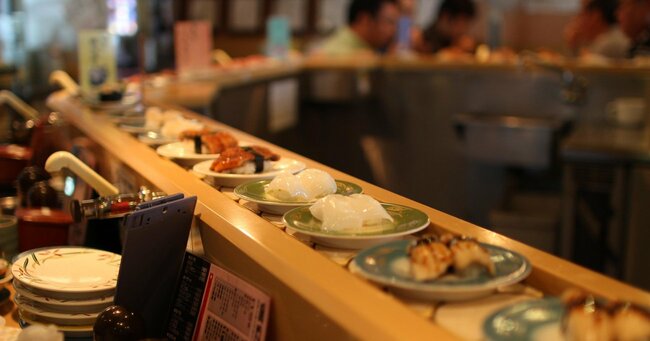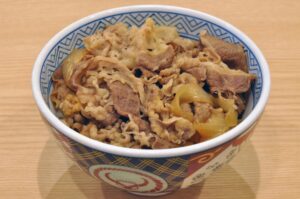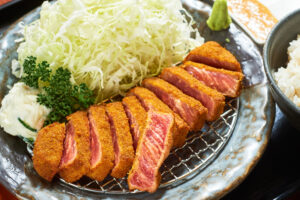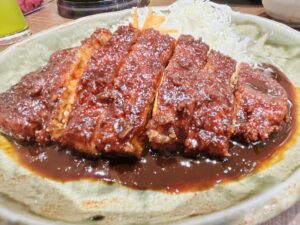As someone born and raised in Japan,
I’ve probably eaten more sushi than I can count – and not always the fancy kind.
I still go to conveyor belt sushi restaurants (kaiten-zushi) a few times a month, and honestly, I’ve been going ever since I was a kid.
It’s affordable, casual, and for many of us Japanese locals, a part of everyday life.
These places aren’t just for tourists – they’re where families gather on weekends, where friends meet after school, and where solo diners stop in for a quick and satisfying meal.
You might think of sushi as a luxury food, but in Japan, kaiten-zushi is for everyone.
If this is your first visit to Japan, I highly recommend trying it at least once – but not just anywhere. Let me show you how locals really enjoy it.
How Conveyor Belt Sushi Works in Japan
When you enter a kaiten-zushi restaurant, you’ll notice a moving belt carrying small plates of sushi that wind through the restaurant, past every table or counter seat.
You can…
- Simply pick the plates you want off the belt
- Or (more common nowadays), use the touchscreen ordering system, available in English, Chinese, and Korean at most major chains
Once ordered, your sushi will arrive in a few minutes – often via a speedy “sushi train” or conveyor directly to your seat. It’s clean, efficient, and quite fun.
Plate Colors = Price
Each plate’s color or pattern indicates its price. A typical price guide:
- White plate = ¥110 (around $0.70 USD)
- Red plate = ¥165
- Gold plate = ¥330
- Black plate = ¥550+ (premium items)
You usually just stack your plates at the end of the meal, and staff (or a robot!) will calculate the total. Many shops even let you insert plates into an automatic counter slot – strangely satisfying.
Where to Eat – My Recommended Kaiten-Zushi Chains in Japan
Not all conveyor belt sushi is equal. If you go to a chain that locals love, you’ll get better freshness, better prices, and a more authentic experience.
Here are four of my top picks:
1. Sushiro (すしろー)
The largest chain in Japan and a consistent favorite among locals. Their menu is constantly updated with seasonal specials like fatty tuna (toro) or uni (sea urchin) at affordable prices.
2. Kura Sushi (くら寿司)
Great for families and kids. When you return five plates, you get to play a gachapon (capsule toy) game at your table. Sushi + prizes = a win-win.
3. Hama Sushi (はま寿司)
Often found in quieter suburban areas. Offers high quality for lower prices and has a broader menu with tempura, ramen, and desserts.
💡Pro Tip: Avoid tourist-heavy areas like central Shibuya or Asakusa during peak hours. Instead, go a bit outside the city center – you’ll find better service and fewer crowds.
What to Order – Local Favorites & Hidden Gems
Even if raw fish isn’t your thing, don’t worry – kaiten-zushi menus are huge. Here’s what I always look for, and what many locals enjoy:
For Beginners:
- Tamago (sweet egg omelet) – soft and slightly sweet
- Ebi Tempura Roll – crispy shrimp in a maki roll, usually served warm
- Roast Beef Nigiri – yes, meat at a sushi place. Delicious with onion & sauce
- Inari Sushi – sushi rice wrapped in sweet tofu pouch
For Sushi Lovers:
- Chutoro / Otoro – medium and fatty tuna, melts in your mouth
- Aburi Salmon (seared salmon with mayo) – smoky, creamy, and a fan favorite
- Engawa (flounder fin) – a hidden gem, chewy with rich flavor
- Uni (sea urchin) – creamy, oceanic flavor. Expensive but worth trying once
Don’t Miss the Sides:
- Miso Soup – warming, classic pairing with sushi
- Chawanmushi (savory egg custard) – soft, dashi-flavored comfort food
- Matcha Green Tea – usually free and self-serve at the table
Sushi Etiquette in Japan – Do’s and Don’ts
Japan is known for its quiet dining culture and etiquette, but don’t worry – locals are understanding as long as you’re respectful.
Here are a few basic tips.
- ☑︎It’s okay to eat sushi with hands or chopsticks
- ☑︎Dip fish-side down in soy sauce (not the rice side)
- ☑︎Say “Itadakimasu” before eating and “Gochisousama deshita” when you’re done
- ✖️Don’t mix wasabi into soy sauce (use it directly on the fish)
- ✖️Don’t return half-eaten plates to the belt (big no-no)
🧾 Payment & Convenience Tips
Most kaiten-zushi shops are modern and tourist-friendly:
- Accept credit cards, Suica/PASMO, and even QR code payments (PayPay, AliPay)
- Many shops have apps or online reservations – especially handy for popular chains like Sushiro
- Some chains even offer takeout boxes or delivery via Uber Eats
Traveling for Sushi? Use a JR Pass
If you plan to travel across cities (Tokyo, Kyoto, Osaka, Sapporo…), a Japan Rail Pass can save you money and time. It’s perfect for sushi lovers who want to try regional specialties:
- Kanazawa – crab and nodoguro sushi
- Kyoto – mackerel (saba) sushi
- Hokkaido – uni and scallops
- Fukuoka – squid and fatty fish
👉 Get your Japan Rail Pass in advance and explore sushi across Japan with unlimited rides.
Final Thoughts from a Local
Conveyor belt sushi is more than just food – it’s a window into modern Japanese culture.
It’s where locals go after work, where families gather on weekends, and where solo diners (like me) feel totally at home.
If it’s your first trip to Japan, don’t miss this chance to enjoy affordable, fun, and surprisingly high-quality sushi in a way that only Japan can offer.
Want to try kaiten-zushi in Tokyo, Osaka, or Hokkaido? Book your hotel near local favorites on [Booking.com] or [Trip.com] and let your sushi adventure begin.









Comments